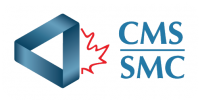PROBLEMS FOR JULY
Solutions should be submitted to
Dr. Valeria Pandelieva
708 - 195 Clearview Avenue
Ottawa, ON K1Z 6S1
Solution to these problems should be postmarked no later than August 30, 2000.
Notes: An acute triangle has all of its angles less than 90°. The orthocentre of a triangle is the intersection point of its altitudes. Points are collinear iff they lie on a straight line.
- 19.
- Is it possible to divide the natural numbers 1, 2, ¼, n into two groups, such that the squares of the members in each group have the same sum, if (a) n = 40000; (b) n = 40002? Explain your answer.
- 20.
- Given any six irrational numbers, prove that there are always three of them, say a, b, c, for which a + b, b + c and c + a are irrational.
- 21.
- The natural numbers x1, x2, ¼, x100 are such that
|
- 22.
- Let R be a rectangle with dimensions 11 ×12. Find the least natural number n for which it is possible to cover R with n rectangles, each of size 1 ×6 or 1 ×7, with no two of these having a common interior point.
- 23.
- Given 21 points on the circumference of a circle, prove that at least 100 of the arcs determined by pairs of these points subtend an angle not exceeding 120° at the centre.
- 24.
- ABC is an acute triangle with orthocentre H. Denote by M and N the midpoints of the respective segments AB and CH, and by P the intersection point of the bisectors of angles CAH and CBH. Prove that the points M, N and P are collinear.



